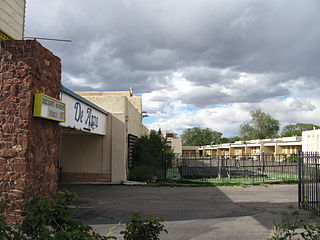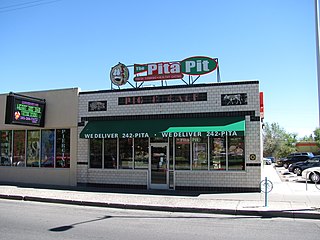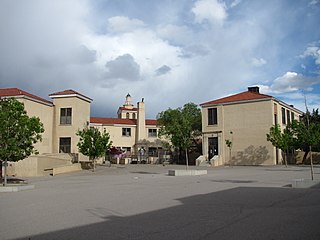
The Occidental Life Building is a historic office building in Albuquerque, New Mexico, in the United States. Featuring an unusual Venetian Gothic Revival architectural style inspired by the Doge's Palace in Venice, the building is one of the city's most recognizable landmarks and has been described as "unique in the country".

The Southwestern Brewery and Ice Company is a historic brewery in Albuquerque, New Mexico, located adjacent to the BNSF railroad tracks in East Downtown. Built in 1899, it is one of the only surviving 19th-century commercial buildings in the downtown area.

Jones Motor Company is a historic U.S. Route 66-era building in Albuquerque, New Mexico. Built in 1939, on Central Avenue in the Nob Hill neighborhood of Albuquerque, the building originally housed Ralph Jones' service station and Ford Motor Company car dealership. It was designed by Tom Danahy in the Streamline Moderne style, with curved garage bays surmounted by a central stepped tower.

The historic U.S. Route 66 ran east–west across the central part of the state of New Mexico, along the path now taken by Interstate 40 (I-40). However, until 1937, it took a longer route via Los Lunas, Albuquerque, and Santa Fe, now roughly New Mexico State Road 6 (NM 6), I-25, and US 84. Large portions of the old road parallel to I-40 have been designated NM 117, NM 118, NM 122, NM 124, NM 333, three separate loops of I-40 Business, and state-maintained frontage roads.

The Hurt Building is an 18-story building located at 50 Hurt Plaza in Atlanta, Georgia with a unique triangular shape. One of the nation's earliest skyscrapers, the Hurt Building was built between 1913 and 1926, and was the initial home for the Federal Reserve Bank of Atlanta. It was renovated in 1985. It was added to the National Register of Historic Places in 1977.

There are 65 properties listed on the National Register of Historic Places in Albany, New York, United States. Six are additionally designated as National Historic Landmarks (NHLs), the most of any city in the state after New York City. Another 14 are historic districts, for which 20 of the listings are also contributing properties. Two properties, both buildings, that had been listed in the past but have since been demolished have been delisted; one building that is also no longer extant remains listed.

Castle Apartments was a historic apartment building in Albuquerque, New Mexico, United States, which was destroyed by fire in 2009. It was located on the southeast corner of 15th Street and Central Avenue, roughly halfway between Downtown and Old Town, and took its name from the Huning Castle mansion, which originally stood on the other side of 15th Street.

The Nathaniel West Buildings in southeast Portland, Oregon, United States, are listed on the National Register of Historic Places. The two structures are part of a group of three, including West's Block, built by West in the late 19th century.

The Southern Union Gas Company Building is a historic building in downtown Albuquerque, New Mexico, which is notable as one of the earliest International style buildings in the city. Built in 1951, it was the largest of several Southern Union offices around the state designed by southwestern architect John Gaw Meem. Meem was much better known for working in the Pueblo Revival style but did design a handful of other modernist buildings, such as the Colorado Springs Fine Arts Center.

The De Anza Motor Lodge was a historic motel located on former U.S. Route 66 in the Upper Nob Hill neighborhood of Albuquerque, New Mexico. It was built in 1939 by Charles G. Wallace, a local trader of Zuni art and pottery, who remained the owner until 1983. Wallace decorated the motel with a variety of Native American art, including a series of murals by Zuni artist Tony Edaakie in a basement room.

First Methodist Episcopal Church is a historic Methodist church at 3rd Street and Lead Avenue in downtown Albuquerque, New Mexico. It was built in 1904 to replace an earlier adobe church on the same site, which the congregation had outgrown. The architect was Charles Frederick Whittlesey. The earlier church, built in 1880–2, was the first church in New Town but had become inadequate by the turn of the century and was torn down.

Nob Hill Business Center is a historic shopping center in Albuquerque, New Mexico. Built in 1946–7, it was the first modern suburban shopping center in New Mexico, and its construction marked a shift away from pedestrian-oriented development in Albuquerque in favor of decentralized, auto-oriented sprawl. Located on Central Avenue at Carlisle Boulevard, the building is the focal point of the Nob Hill district.

The Pig & Calf Lunch, also known as the Pig Stand Cafe, is a historic building in Albuquerque, New Mexico. It is notable as a largely original example of mid-1930s commercial architecture. The building was added to the New Mexico State Register of Cultural Properties in 1993 and the National Register of Historic Places in 1994.

Monte Vista Elementary School is a public elementary school in the Nob Hill neighborhood of Albuquerque, New Mexico, whose campus is listed in the New Mexico State Register of Cultural Properties and the National Register of Historic Places. It is notable as one of the city's best examples of Mediterranean Revival architecture and as the historical focal point of the surrounding neighborhood.

The Washington Apartments are a historic apartment complex in Albuquerque, New Mexico. The property is notable as a well-preserved example of early 20th-century apartment construction in the city, along with the Eller Apartments and Newlander Apartments. The apartments were built in 1916 by local businessman James D. Eakin and, as of 1981, had remained relatively unaltered. The complex is listed in the New Mexico State Register of Cultural Properties and the National Register of Historic Places.

The Newlander Apartments are a historic apartment building in Albuquerque, New Mexico. Originally built as a single-family house around 1910 and expanded via a number of additions, it is notable as a well-preserved example of the small boarding houses and apartment buildings that housed much of Albuquerque's working-class population in the early 20th century. The building is listed in the New Mexico State Register of Cultural Properties and the National Register of Historic Places.

Monte Vista Fire Station is a historic former fire station in the Nob Hill neighborhood of Albuquerque, New Mexico. Built in 1936 using Works Progress Administration funding, it is notable as a well-preserved WPA municipal project and for its significance in the early development of the Nob Hill area. The building served in its original role as a fire station until 1972 and currently houses a restaurant. It is the city's second oldest surviving fire station after the AT&SF Fire Station, built in 1920.

The Charles W. Lewis Building is a historic building in the Barelas neighborhood of Albuquerque, New Mexico. It is listed on the New Mexico State Register of Cultural Properties and the National Register of Historic Places. It was built around 1882 by Charles W. Lewis (1844–1901), a native of Peralta, New Mexico who came to Albuquerque in 1873. Lewis was one of many Albuquerque residents to get involved in land speculation as the Atchison, Topeka and Santa Fe Railway approached the town in the late 1870s. Once the railroad arrived, Lewis was able to subdivide a valuable piece of land near the tracks and used one of the lots for the building described here, which was probably built as rental housing. In 1915 it was reportedly being operated as a saloon.

Scholes Hall is the historic administration building of the University of New Mexico, located on the main campus in Albuquerque. It was the first of many buildings designed for the university by Santa Fe architect John Gaw Meem, who helped to cement the Pueblo Revival style as the "official" architecture of the campus. Built in 1934–36 with Public Works Administration funding, it is regarded as one of Meem's most notable designs.

The A&P Superintendent's House is a historic house in the Barelas neighborhood of Albuquerque, New Mexico. It was built in 1881 for Frank W. Smith, who used it as his base of operations while supervising construction of the Atlantic and Pacific Railroad from Albuquerque to Needles, California. It is built from red sandstone, believed to have been quarried near Laguna Pueblo, which was the same material used to build the A&P's maintenance facilities on the opposite side of Second Street. Those buildings were replaced by the Santa Fe Railway Shops beginning in 1912, leaving the Superintendent's House as the city's only surviving building associated with the A&P. The house was listed on the New Mexico State Register of Cultural Properties in 1975 and the National Register of Historic Places in 1978.

























